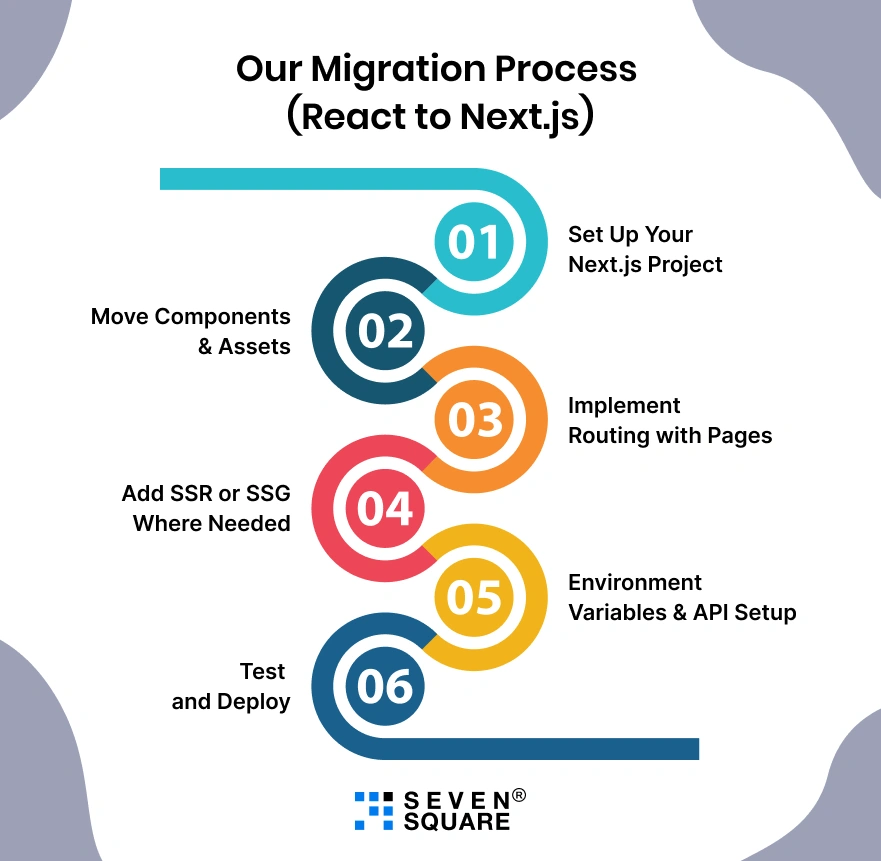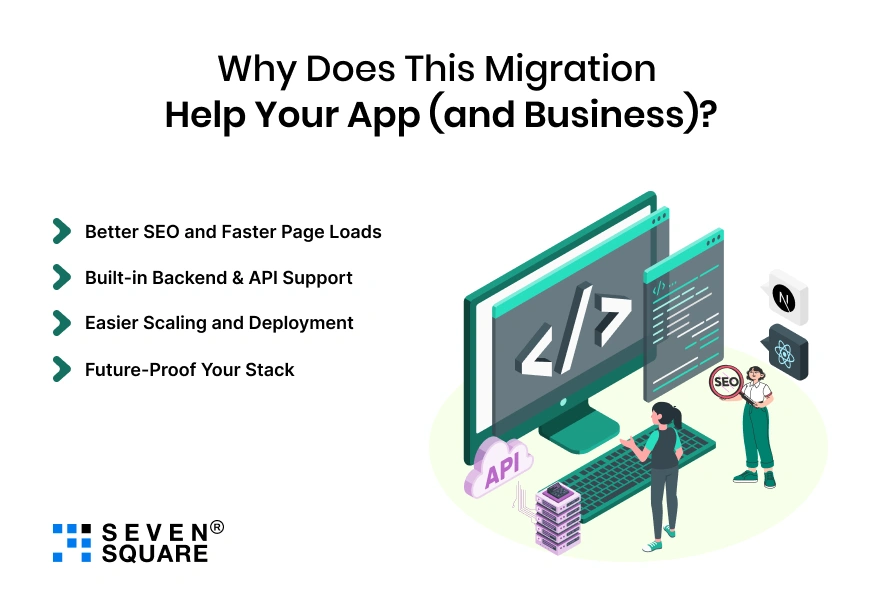Still, running your app on plain React JS?
It’s fast & flexible but as your project grows, things get messy.
You’re probably juggling manual routing, adding extra libraries for server-side rendering, and struggling with SEO optimization.
That’s where Next.js comes in.
At Seven Square, we’ve migrated several complex apps from React to Next.js, and the results are faster performance, better SEO, and cleaner code.
In this blog, we’ll show you exactly how to migrate your React JS app to Next.js, step-by-step, with real code examples.
Are you trying to learn more about React to Next.Js migration? This blog is perfect for you.
Why do People Migrate React App to Next.js?
Thinking about upgrading? You’re not alone.
More developers and businesses are switching from React to Next.js and here’s why:
- Built-in Routing (No More React Router Headaches): Next.js uses file-based routing, which means less setup and fewer bugs. Just create a file in the pages/ folder, and it’s instantly a route.
- Server-Side Rendering (SSR) and Static Site Generation (SSG): With Next.js, you get SSR and SSG right out of the box, without extra configuration. That means faster load times and better SEO, especially important if your business relies on organic traffic.
- Improved Performance and Code Splitting: Next.js automatically splits your code for better performance. Users load only what they need & make your app fast and more efficient.
- Fully Compatible with React: Already have a React codebase? Good news, Next.js is 100% compatible with React. You can migrate incrementally without rewriting your entire app.
Explore the difference between ReactJs vs JavaScript.
Trying to get React to Next.js migration guide then here you will get all the details.
What Are the Common React to Next.js Migration Mistakes to Avoid?
Migrating from React to Next.js can unlock serious performance, SEO, and scalability benefits, but only if you do it right.
We’ve seen many devs (and teams) trip up by overlooking the basics.
Here are some common mistakes to avoid during React JS to Next JS migration:
1. Not Replacing React Router Properly
- React apps typically use react-router-dom, but Next.js has its own built-in routing system based on the pages/ directory.
- If you don’t replace your routing correctly, your navigation might break or load the wrong components.
- Skip React Router entirely and use file-based routing in Next.js instead.
- Tip: Each file in the pages/ folder becomes a route, no extra libraries are needed.
2. Breaking SSR/CSR Behavior by Misusing useEffect
- In React, useEffect is used for client-side effects.
- But in Next.js, you also have server-side rendering (SSR) and static generation (SSG), which require different lifecycle methods like getServerSideProps or getStaticProps.
- Using useEffect for data fetching can lead to delayed rendering and poor performance, especially for SEO-critical pages.
- Tip: Use getStaticProps or getServerSideProps for data that should load before rendering.
3. Skipping Dynamic Route Handling with [id].js Files
- React devs often use params and route props to handle dynamic routes.
- In Next.js, you need to create files like [id].js in the pages/ directory to manage dynamic routing.
- Missing this will break your blog pages, product listings, or any URL that depends on dynamic content.
- Tip: Use [slug].js, [id].js, or catch-all routes like […params].js for flexibility.
Avoiding these common migration pitfalls will save you hours of debugging and help you get the full benefits of moving from React to Next.js.
This complete React to Next.js tutorial will ensure you can Convert React app to Next.js without any mistakes.
Learn to create Dynamic Thumbnails in ReactJs.
Our Migration Process (React to Next.js)

We’ve migrated multiple production apps from React to Next.js, and it doesn’t have to be complicated.
Here’s the step-by-step process we follow every time, with code and explanations to make your React JS to Next JS migration smooth and error-free.
Step 1: Set Up Your Next.js Project
Start by creating a new Next.js project:
npx create-next-app@latest my-nextjs-app
cd my-nextjs-app
npm run dev
Copied!
This sets up your pages/, public/, and styles/ directories automatically.
If your existing React app uses a src/ folder, you can keep that structure, just make sure your pages go into the pages/ folder in Next.js.
Step 2: Move Components & Assets
Move reusable components from your React app into the components/ folder of your Next.js app:
📁 src/
┣ 📁 components/
┃ ┗ Header.js
┃ ┗ Footer.js
┣ 📁 assets/
┃ ┗ logo.png
┣ 📁 styles/
┃ ┗ globals.css
If you’re using Tailwind CSS or CSS Modules, install and configure them like this:
npm install -D tailwindcss postcss autoprefixer
npx tailwindcss init –p
Copied!
Add this to your tailwind.config.js:
content: [
"./pages/**/*.{js,ts,jsx,tsx}",
"./components/**/*.{js,ts,jsx,tsx}"
],
Copied!
And import the base styles in ./styles/globals.css.
Step 3: Implement Routing with Pages
Ditch react-router-dom. Next.js uses file-based routing, you create routes by creating files inside the pages/ folder:
React (Old Way):
< Route path="/about" element= { < About/ > } / >
Copied!
Next.js (New Way):
📁 pages/
┗ about.js
Js
// pages/about.js
export default function About() {
return < h1 > About Us < /h1 >;
}
Copied!
Dynamic routes? Use [id].js or [slug].js:
// pages/blog/[slug].js
export default function BlogPost({ params }) {
return < div > Post slug: {params.slug} < /div > ;
}
Copied!
Step 4: Add SSR or SSG Where Needed
Replace useEffect with the right data fetching method:
For Static Site Generation:
export async function getStaticProps() {
const res = await fetch('https://api.example.com/data');
const data = await res.json();
return {
props: { data },
};
}
Copied!
For Server-Side Rendering:
export async function getServerSideProps(context) {
const res = await fetch (`https://api.example.com/user/${context.params.id}`) ;
const user = await res.json();
return {
props: { user },
};
}
Copied!
Step 5: Environment Variables & API Setup
Use .env.local for your keys:
NEXT_PUBLIC_API_URL=https://api.example.com
Copied!
To keep secrets server-side only (e.g., API keys):
API_SECRET_KEY=your_secret_key
Copied!
If you’re migrating an Express backend, you can either:
- Continue running Express separately
- Use Next.js API routes like so:
// pages/api/hello.js
export default function handler(req, res) {
res.status(200).json({ message: 'Hello from Next.js API!' });
}
Copied!
Step 6: Test and Deploy
Run the build and test everything:
npm run build
npm start
Copied!
Optimize assets and add
import Image from 'next/image';
import Link from 'next/link';
Copied!
Deploy to Vercel (recommended for Next.js):
npx Vercel
Copied!
Or deploy to platforms like Netlify or your own VPS using Docker.
That’s It, React to Next.js Migration Done Right.
Want to see the working code? Check out our Step-by-Step React to Next.js migration guide on GitHub.
By following these steps, you get:
- Faster performance with automatic code splitting
- Better SEO with server-side rendering
- Scalable routing without extra libraries
- Smooth integration with your existing React code
Want to migrate React app to Next.Js? Contact Us Now!
Why Does This Migration Help Your App (and Business)?

Still wondering if React to Next.js migration is worth the effort? Here’s how it pays off, not just in code, but in real business results.
- Better SEO and Faster Page Loads: Next.js improves SEO with server-side rendering and speeds up load times using automatic code splitting and optimized performance defaults.
- Built-in Backend & API Support: Use built-in API routes in Next.js, no need for a separate Node.js or Express backend for common tasks.
- Easier Scaling and Deployment: Deploy fast to Vercel or Netlify. Scale easily with serverless functions, hybrid rendering, & zero-config infrastructure support.
- Future-Proof Your Stack: Next.js supports React Server Components and the App Router to ensure your stack stays modern, efficient, and scalable.
FAQs
- Migrating to Next.js offers better SEO, faster performance, built-in routing, and server-side rendering, helping your app scale and rank better.
- Yes. Next.js is built on top of React, so you can reuse most of your React components and libraries during migration.
- With SSR, pages are pre-rendered on the server, allowing search engines to crawl meaningful HTML instead of waiting for JavaScript.
- With a clear structure, you can migrate in a few days. Complex apps may take longer depending on routing and API logic.